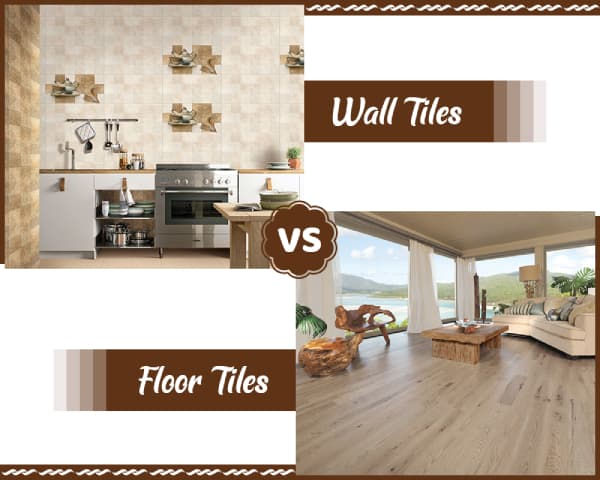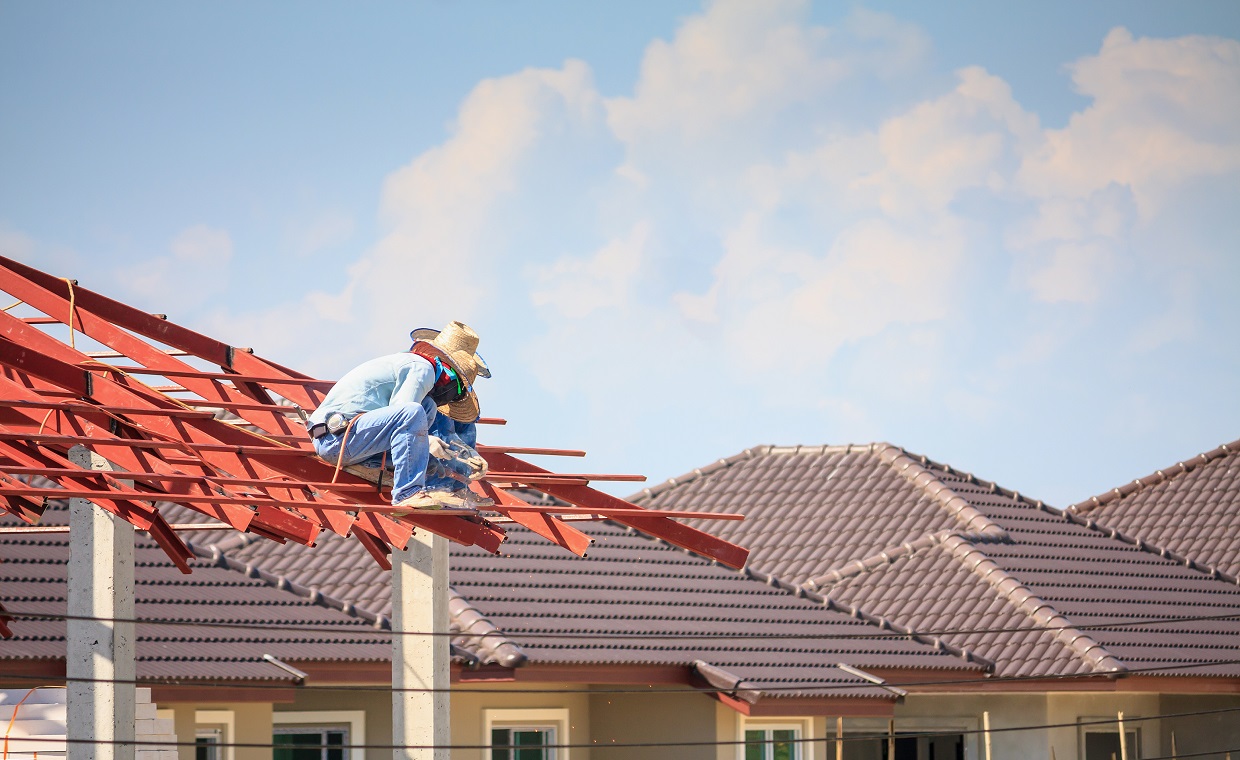
Tiles are now widely used in indoor and outdoor areas in both residential and commercial buildings. The installation of these tiles enhances the look and equally boosts the convenience of maintaining the surface area. Different types of tiles are available in the market, and for the beginners, it often becomes confusing to decide between the varieties.
For example, both floor tiles and wall tiles are ceramic made, and they are available in the same designs also. But are these two variants the same? Can you use both the variety interchangeably? The knowledge is important because it will help you bag the best deal while buying tiles, and cherry-pick the best products for your use. Above all, there is no harm in becoming an information junky! But before we plunge into the comparison chart, take a quick look at what tiles are basically.
Tiles are an integral part of modern Home decoration. Contemporary home decor is a kind of environment-friendly architectural art whose purpose is to create beautiful indoor settings, better functionality, and ease of maintenance. It should bean eco-friendly combination of architectural elements, building materials, colors, furniture, etc.
The tiles are thin decor elements used for covering different building surfaces like walls, floors, roof, etc. Tiles are made from clay or other inorganic raw materials and can be either of glazed or unglazed variety.
Tiles may be either roof tiles, wall tiles or floor tiles depending upon the types of the surfaces they cover. The difference is just not in name, but basically in properties depending upon the types and uses to where they are put no matter if they look almost the same.
Let us discuss now the difference between wall tiles and floor tiles.
What is the Difference in the Properties of Wall Tiles and Floor Tiles?
01. Definition of Tiles
Wall tiles or dado tiles are the tiles that can be used for the wall. According to ‘M L Gambhir and Neha Jamwal’[352] (Author of a book called Building and Construction Materials: Testing and Quality Control), Wall tiles are mostly glazed tiles with a thin body used as a decorative material for building wall surfaces.
A tile that can be used for the floor is known as the floor tiles.


02. Types of Load to which they are Subjected
Wall tiles are not the subject to any traffic load or any abrasive wear and tear. Hence they can be of lesser resilience i.e. less in thickness.
However, gravitational load always acts on them trying to pull them down. Hence they should be as lightweight as possible. Generally they are smaller in size so that the thinner texture is also maintained. If you increase the size, the thickness will get simultaneously increased and if you increase the thickness it will unnecessarily add to its weight, which may result in its fall over a period of time.
Floor tiles are the subject to heavy traffic load as well as related wear and tear. Hence they have to be strong i.e. these tiles are built with more thickness. Further, as there is zero-risk of drop down, these tiles are designed with larger size as possible to manufacture so that the number of joints decreases and contributes to increasing its aesthetics.
03. Size of Tiles
As they are needed to be lightweight, wall tiles are usually smaller in size and thinner in texture. There is no visible difference in the appearance of a wall tile and floor tile but wall tiles are usually smaller in size and light-in-weight.
As there is no restriction on weight, floor tiles can be of large size, thicker texture, and hence for relevant reason heavier. From the aspect of appearance, both look same, however floor tiles are thicker than the wall tiles. Despite of their apparent similarity, mostly because of larger size, floor tiles allow the privilege of inserting less number of joints on the surface at the time of its installation.


04. Tiles PEI Rating (Porcelain Enamel Institute Rating)
Mostly the tiles come labeled with Porcelain Enamel Institute Ratings (PEI Rating). According to the ‘Mark Johanson’[354] (Editor of Book: Black & Decker The Complete Guide to Tile), PEI Rating indicates how a tile should be used and if it needs to be sealed against moisture. The PEI number is a wear rating that indicates how the tile should be used.
The PEI Number of 1 and 2 indicates that the tiles are suitable for walls only.
The PEI Number of 3 and 4 indicates that the tiles are suitable for all residential purposes, i.e. walls, floors, countertops, etc.


05. Is it Okay to Use Wall Tiles on the Floor or Floor Tiles on Wall?
No. Wall tiles are not suitable to use as floor tiles because they are smaller in size and thinner in texture, hence they are not durable (resilient enough) for a floor-surface. Also Wall tiles are not heat resistant enough, which a floor may need to withstand. Hence, if wall tiles are used on floor, the tiles will show less adaptability to high traffic loads and there is risk that the exerted high pressure may create cracks causing the breakage of tiles. Furthermore number of joints will compromise the consistent beauty of the floor.
Floor tiles and wall tiles cannot work interchangeably because the size of the floor tiles is bigger than the wall tiles. Floor tiles are mostly manufactured to withstand higher amounts of wear and tear. You will not be able to fit them onto your wall without cutting them down to proper size. If you fix floor tiles on wall because of larger size and heavyweight, they may fall over a period of time, hence not recommended.
06. Manufacturing of Tiles
The wall tiles are manufactured in a way so that they are durable. But by default these tiles are built with a unique capacity to hold higher amount of pressure as compared to floor tiles.
Floor tiles are manufactured in a way so that they are durable, able to sustain pressure and highly resistant to wear and tear.
07. Which is the More Durable?
Wall tiles are normally less durable than the floor tiles and they are unable to hold much pressure as floor tiles can do. this happens due to the thin texture of wall tiles.
Floor tiles are more durable than the wall tiles. These tiles are more resistant to pressure.


08. Maintenance of Tiles
Wall tiles require lower maintenance and can be easily cleaned with water and soap.
Floor tiles need a higher level of maintenance. It requires special detergents and cleaning materials for day to day cleaning.
09. Tiles Fittings
Concerning fitting, similar method is used for the installation of wall tiles as well as floor tiles. First, prepare the surface for the tiles for fitting and then begin your layout. In the next step, apply the adhesive and cut the tiles if needed. After setting your tiles, apply grout to the joints. To know about more about tiles fitting, Read – All About Tile Installation & Its Precautions
Wall tiles are thinner and lightweight so they can be easily shaped, sized, and installed. Read – Do’s and Don’ts While Doing Dado Tiles Work, to know the process in detail. Normally tile section on white chalk is drawn on the wall before fixing them. Sometimes bolting techniques might also be applied for fixing the tiles.
Floor tiles are thicker and heavier than wall tiles, and hence they cannot be easily sized and installed.



10. Tiles Installation Costs
- The first step for calculating the tile installation cost is to measure the exact quantity of tiles required for the room.
- Nowadays, wall tiles and floor tiles can be installed with readymade tile adhesive instead of traditional sand and cement mortar.
- If you use adhesive for fitting the wall tiles, then find the cost of adhesive and tiles. Multiply the rate of adhesive with total square feet of tiles requires in your room to find out the total material cost.
- If you use cement and sand mortar, then find the tile installation cost as per standard specifications or use Gharcalculator.
Note:
Rate of the material varies from one place to another. Therefore the overall tile installation cost for both wall tiles as well as floor tiles will vary from place to place.
Installation costs are lower as less amount of mortar is required.
Installation costs are higher as mortar thickness is more.
11. Tiles Lifespan
The life span of wall tiles is more than 75 years if properly installed.
The life span of floor tiles is more than the wall tiles. However, If you use wall tiles as a floor tiles then it will need a quick replacement.
12. The Dimensions of the Room Taken During Estimating
You have to count on the Length and Height of the tiles and the surface area while calculating the cost of wall tiling.
You have to count on the Length and Width of each tile vs the surface area while calculating the cost of floor tiling.
Taking everything into account, the primary difference between wall tiles and floor tiles is their size and thickness depending upon the materials used for their production, and the glossy surface of the tiles. The material used in the manufacturing of both the tiles, i.e. wall tiles and floor tiles may or may not be different. But the functions of both tiles are different. Floor tiles require greater strength as compared to the wall tiles as the floor has to withstand heavy load of traffic and the risk of wear and tear related to this heavy duty traffic movement.
For more detail, Also Read –
How to Choose Tile Colour According to Your Room colour Scheme?
LeatherTiles: A Contemporary Choice for Flooring
Vitrified Tiles: All You Like to Know!






























